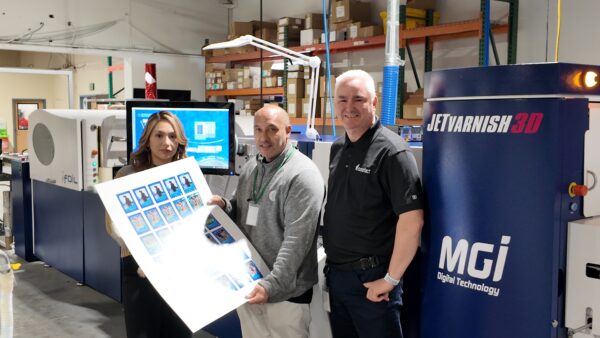Label and Barcode Printers Gain Traction as a Viable Diversification Opportunity
Diversification enables dealers to become “stickier” with their customers, offering more than just traditional office printing technology. An emerging product segment that enables dealers to get “stickier” both literally and figuratively with their customers are label and barcode printers. And selling these products shouldn’t be a stretch even if it isn’t a slam dunk.
“From a dealer perspective, we’d like to think that selling label printing equipment and solutions is not much different than selling production and graphics print””but, it is very different,” observed Todd Culbertson, production print manager at Impact Networking LLC’s Bolingbrook facility in northeastern Illinois.
Impact Networking, based in Lake Forest, Illinois, is one of the top production dealers in the United States, offering both Konica Minolta and Ricoh. It also is an M5 Dealer for RISO high-speed inkjet products and a contractual HP wide-format dealer. Label printing is one segment of the market in development, Culbertson shared.
Label opportunities can be discovered among existing and new customers, according to the OEMs.
“Analysts are predicting this market will expand to more than $45 billion by 2022,” reported Russell Doucette, product marketing manager at Konica Minolta Business Solutions U.S.A. “Who doesn’t want to be a part of this explosive growth?”
On the thermal-barcode side, market research firm TechNavio has estimated that the 1.2 billion smartphones sold annually would require 18 billion printed labels to support these products.
“Also consider the number of food items we consume daily and the number of labels required to identify and transport these items from farms to stores to tables,” added Theresa Lee, product manager at Toshiba America Business Solutions. (See sidebar.)
The Label Production Challenge
Of course, label production comes with its share of challenges. The biggest obstacle may be effectively articulating the breadth of the opportunity.
“We need to work with our dealers to educate and guide them to the large array of businesses that can be transformed through the customization and personalization offered by the latest label technology,” noted Konica Minolta’s Doucette.
He added that sometimes label customers can be a different breed.
“It is more of a solution sale and requires a distinctive language, vocabulary, and expertise,” said Doucette. “The keys are understanding and exploring the vast creative possibilities that new digital technology has enabled. We need to help dealers tap into the excitement we see when customers realize these products can be game-changers for them.”
There also is investment strategy aspect to consider.
“It’s an opportunity for dealers to be able to diversify but still invest in what they know,” added Doucette. “They know printing, and one step in label production is putting ink (or toner) on a substrate.”
Expertise and Time
Lack of label expertise indeed is a challenge.
“For a lot of dealers, having a production-print specialist is a dream,” said Impact’s Culbertson. “We are fortunate to have a team of six overlaying more than 100 sales reps.”
Hiring an experienced, knowledgeable individual in this role is critical. He or she needs to understand production and graphic digital printing””and the motivation of buyers.
“Unfortunately, these folks rarely have any label experience, so that must be learned,” said Culbertson. And there is a lot to learn.”
According to Culbertson, the term “digital label printing” seems new when compared to the more traditional technologies that dominate the space.
Impact Networking understands the digital and the transformation that has taken place over the past decade or so. However, success in the label space requires an understanding of the former and current non-digital methods, understanding strengths and weaknesses, and selling against them, or being a complement to it, explained Culbertson.
Design is the first step in the print process, and Culbertson said it’s the usual disconnect from the finished product. The ranges of sizes of labels compared to digital cut-sheet sheet sizes can create a challenge. Usually, one label size is created and sent to print, in the thousands.
Depending on the application, design might be the first opportunity to change the print process while delivering better results.
“We are developing a proof of concept with a client to gang up a dozen labels all on one cut sheet,” explained Culbertson. “For each piece of equipment they all go on, instead of a dozen rules to deal with.”
Label workflow is different, too. For clients wanting to in-source, their software needs to “see” how their designs are going to be laid out and sent to the printer.
“Usually, gang-up features are involved, like in a Fiery,” said Culbertson. “A whole new toolset will need to be mastered to accomplish this,” which leads to yet another challenge to overcome, service training.
A tech might need to be taken out of the field for days or weeks to get trained on one machine, or a family of machines. There’s transportation, room, and food costs, in addition to training fees. The decision is to sell the box first, then get trained, or train first, and risk having those newly learned skills quickly fade if it takes weeks or months for the very first sale.
“Developing a good go-to-market strategy, then rolling it out and prospecting for new business, while also keeping your eye on the training dates, so you can act quickly and schedule it if the first deal is certain,” said Culbertson. “This approach gives you your best chance of selling it and being ready to set it up and service it.
Another challenge, and a major lack of understanding, is finishing.
“There are few systems where everything is inline, like our production presses””die cutting, laminating, UV coating, flat sheet and roll,” noted Culbertson. “What type of process is involved in getting it off the sheet or roll and onto the widget?”
But the biggest challenge label production poses could be the time it takes to learn. The best way to learn, said Culbertson, is by doing and he recommends investing the time into piecing together a solution and making it work.
Opportunities Abound
Once the challenges are met, there are ample opportunities in the label segment.
“If you ask some targeted questions, it’s not hard to feel like you found an opportunity in labels,” Culbertson acknowledged.
Warehouse space, changes in content, document obsolescence, new design concepts, color management””all or some of these could lead to opportunities.
“When you hear that a company spends $700,000 a year on labels, it’s difficult to turn your back on that kind of spend,” stated Culbertson.
Nearly every case is a research project for Culbertson and the Impact team.
“We are selling into accounts and walking right by the labels, but some motivations are the same,” he said. “We are training reps to ask, “˜What’s in the box?’ because there are usually a lot of printed pieces in there: the instruction manual, warranty card, registration card, assembly instructions. How about the label?”
Doucette reports many current customers are already using labels, and some are probably buying them from someone else.
“But more and more companies are looking for a better solution,” he insisted. “The trends toward shorter product lifecycles, customization, and personalization are creating a more urgent need for speed and flexibility in the market.”
Konica Minolta believes that digital label printers are the ideal answer to these needs.
As for new customers, Konica Minolta advises prospecting to start-ups and new small- and mid-size companies.
“These types of companies previously could not deploy digital label technology due to scale, timeliness, and cost,” suggested Doucette. “We’ve entered an era where creative marketing and getting your message out there to cut through the noise is more critical than ever. Standing out has become a business imperative.”
Evolving Technology
Impact Networking has seen the evolution with its current clients who have label presses and want to get into digital printing. That shift is an easy one for them. It has a Konica Minolta Bizhub Press C71cf label press at an account. Impact’s Culbertson said it was the right machine at the right volume for the right application.
“There was an expansive check-list to go through to get to that point, but it was a great fit,” he added.
Impact has passed on many others where it wasn’t the right fit because it didn’t have a source for the right equipment at the time.
“We are currently working on the proof of concept from above whereby new designs are being considered, layout software is being tested, and HP latex wide-format printing technology is being explored,” said Culbertson.
The big deal here is the finishing””laminating and digital die-cutting to produce a durable, five-year set of labels on a cut sheet associated with this one SKU.
“There are 300-plus SKUs at this company, so developing the new process and verifying the finished product are key,” stated Culbertson. “We’ve seen the small desktop units, the medium-size OKIs and the Precision Label devices. I would expect we will learn them all over time, as we have the time to invest in making them part of a solution.”
The OEMs foresee technological innovation accelerating in the label space.
“We’re going to see a lot more technology and faster development times,” predicted Konica Minolta’s Doucette. “As an industry, we’re seeing new players coming in, and we’re also seeing typical label manufacturers expanding into new, digital solutions, [which is] a challenging but important first step.”
Konica Minolta is on its second-generation engine technology, with its third generation slated for launch in September at Labelexpo Europe. That tradeshow is itself evidence of the growth in labeling, as nearly 30% of Labelexpo Americas’ 2018 exhibitors were new to the exposition floor. Because Konica Minolta offers toner and inkjet label solutions, the manufacturer can maintain a leading [market] position no matter what the technology, said Doucette.
“Inkjet print technology, as a whole, is a growing trend, and this will continue into the label printing market,” concluded Doucette. “Investment costs for all label printers are diminishing, and the printers are getting easier to install, operate, and service.”
Sidebar: The Business of Barcodes
Another primary challenge of selling label printers is educating the public on the importance of barcode labels used to ensure efficiency within the supply chain.
“They are the backbone of the transportation/logistics, retail, manufacturing, and distribution industries,” asserted Toshiba America Business Solutions Product Manager Theresa Lee.
Barcode printers are typically only deployed in warehouse and distribution areas where the logistics of shipping goods to customers rely on barcode labels to identify, track, and move inventories, explained Lee.
“Many of us may think of printers as a piece of equipment to generate labels without considering how to best optimize the products by integrating label printers into an automated print-and-apply or conveyor system,” explained Lee.
As more organizations emphasize automation within their logistics operations to keep pace with the expansion of e-commerce, Toshiba is facilitating this effort by integrating best-in-class barcode printing technology with synergistic integration partners to enable automation.
In addition to integrating barcode printers into print-and-apply or conveyor models, radio-frequency identification (RFID) is another key opportunity.
“As the price of RFID tags and the surrounding infrastructure costs stabilize, more adoption will occur,” predicted Lee. “Most of the barcode printers may encode RFID tags, but these printers will need upgrades for added speed.”
Other opportunities include niche markets such as internal verifiers.
“Verifiers are built into the printer for scanning barcode labels after printing to verify readability,” said Lee. To avoid non-compliance fines, “segments such as pharmaceutical must meet mandatory compliances to ensure barcode labels are scannable.”
“Compliance regulations can also make for a viable [label] production revenue stream,” added Konica Minolta’s Doucette. “Companies often need to react quickly to new regulations in reporting information regarding healthcare, food ingredients, etc., which means reprinting current labels. Product offerings are also constantly changing””new options, flavors, and sizes, leading to updated packaging opportunities. Solutions for pressure-sensitive digital labels combined with advanced inkjet and toner label technology allow users to be agile and meet these technical requirements quickly while keeping cost under control.”
Equipment evolution can be slow and steady in the barcode segment.
“Thermal printing technology does not change rapidly,” said Lee.
Reliability and ease of integration are paramount.
“Instead of looking at the printer as a stand-alone unit, office equipment resellers should seize upon the trend of automation, while helping organizations integrate the labeling function into a fully automated, warehouse-management/shipping system,” suggested Lee.
Access Related Content
Visit the www.thecannatareport.com. To become a subscriber, visit www.thecannatareport.com/register or contact cjcannata@cannatareport.com directly. Bulk subscription rates are also available.




